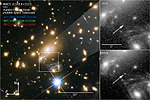히페리온 proto-supercluster
Hyperion proto-supercluster| 히페리온 proto-supercluster | |
|---|---|
 는 히페리온 proto-supercluster의 가시화. | |
| 관측 데이터(Epoch J2000) | |
| Constellation(s) | 육분의 자리 |
| 적경 | 10h 6m짜리 |
| 적위 | 2.3° |
| 주요 축 | 150Mpc(489Mly) |
| 사소한 축 | 60Mpc(196Mly) |
| 적색 편이 | 2.45 |
| 질량 Binding | 4.8×1015 M☉ |
하이페리온 원초 초은하단은 우리 은하 질량의 5,000배이며 현재 우주의 20퍼센트 정도에서 볼 수 있는 가장 크고 초기의 초은하단입니다.그것은 2018년 칠레의 초대형 망원경으로 관측된 10,000개의 물체의 적색편이를 분석하여 발견되었다.
검출
Olga Cucciati가 이끄는 발견 팀은 컴퓨터 천체물리학 방법과 천체정보학을 사용했다. 통계 기술은 가시 구조의 [3]중력 상호작용(바이럴라이제이션)을 상관시키기 위해 2차원 Voronoi 테셀레이션을 사용하여 은하 적색편이의 대규모 데이터 세트에 적용되었다.보이지 않는(암흑 물질) 구조의 존재를 추론했다.[citation needed]
상관관계는 [4]칠레에 있는 초대형 망원경의 VIMOS(Visible Multi Object Spectrograph) 기구를 사용하여 VIMOS-VLT Deep Survey라고 불리는 하늘 조사에서 포착된 적색편이 데이터와 그보다 적은 범위의 다른 조사를 기반으로 했다.3,822개의 물체(은하)에 대한 분광적 적색편이 데이터가 [5]선택되었다.
이 발견은 2018년 [4]9월에 천문학과 천체물리학에 발표되었습니다.
물리적인 설명
이 구조의 무게는 4.8 × 1015 태양 질량(은하의[6] 약 5,000배)이며 60 Mpc × 60 Mpc × 150 Mpc(196 Mly × 196 Mly × 489 Mly)[7][8]로 추정된다.이것은 육분의자리 [4]2평방도의 우주 진화 조사(COSMOS) 영역 내에 있습니다.하이페리온의 적색편이는 z=2.45로[7] 지구에서 110억 광년 떨어져 있으며,[9] 현재 우주의 나이보다 20% 미만에 존재했다.결국 그것은 "슬론 만리장성이나 처녀자리 초은하단을 구성하는 초은하단과 같은 지역 우주의 거대한 구조와 유사한 것으로 진화할 것으로 예상된다."[10]
우주론에서 사용
초은하단은 암흑 물질을 포함하고 있으며, 그 안에 있는 가시적인 물체와 계산된 중력 결합 사이의 불일치로 증명된다.초기 우주의 유물로써, 암흑 물질 데이터는 우주 [8]이론들을 테스트하는데 사용될 수 있었다.2018년 논문 저자들이 지적했듯이, 람다-CDM [11]모델의 "높은 적색 편이에서의 거대하고 복잡한 프로토클러스터의 식별은 암흑 물질 시뮬레이션에 제약을 주는 데 유용할 수 있다."
「 」를 참조해 주세요.
- Lynx Supercluster, 적색 이동 z=1.26–1.27(형성 거리 또는 시간)에 대한 이전 기록 보유자 슈퍼클러스터
- CL J1001+0220, z=2.5에서 2016년 이후 기록 보유 은하단
참조
- ^ Katherine Hignett (October 17, 2018), "Astronomers Find Largest Galaxy Proto-supercluster", Newsweek – via MSN
- ^ Largest Galaxy Proto-Supercluster Found – Astronomers using ESO's Very Large Telescope uncover a cosmic titan lurking in the early Universe, European Southern Observatory (ESO), 17 October 2018, Science Release eso1833, retrieved 18 October 2018
- ^ Cucciati 등 2018. 오류:: 도움말
- ^ a b c Doris Elin Salazar (October 17, 2018). "Meet Hyperion: Colossal Supercluster in the Early Universe". Space.com.
- ^ Cucciati 등 2018, 페이지 3. 오류:
- ^ Don Lincoln (October 21, 2018), This 'supercluster' of galaxies lets us peek into the universe's past, CNN
- ^ a b Cucciati et al. 2018, 페이지 1. 오류::
- ^ a b Nicole Mortillaro (October 17, 2018), Astronomers find most massive structure in the early universe: Proto-supercluster may contain thousands of galaxies, CBC
- ^ Natalia A. Ramos Miranda (October 17, 2018), "Scientists in Chile unveil 'A Cosmic Titan' cluster of galaxies", Reuters
- ^ "Astronomers Find A Cosmic Titan In The Early Universe", Keck Observatory News (website), Kamuela, Hawaii: W. M. Keck Observatory, California Association for Research in Astronomy, October 19, 2018, retrieved 2018-11-22
- ^ Cucciati et al. 2018, 페이지 17. 오류:: (도움말
원천
- Cucciati, O.; Lemaux, B. C.; Zamorani, G.; Le Fèvre, O.; Tasca, L. A. M.; Hathi, N. P.; Lee, K.-G.; Bardelli, S.; Cassata, P.; Garilli, B.; Le Brun, V.; MacCagni, D.; Pentericci, L.; Thomas, R.; Vanzella, E.; Zucca, E.; Lubin, L. M.; Amorin, R.; Cassarà, L. P.; Cimatti, A.; Talia, M.; Vergani, D.; Koekemoer, A.; Pforr, J.; Salvato, M. (2018). "The progeny of a cosmic titan: A massive multi-component proto-supercluster in formation at z = 2.45 in VUDS". Astronomy & Astrophysics. 619: A49. arXiv:1806.06073. Bibcode:2018A&A...619A..49C. doi:10.1051/0004-6361/201833655. S2CID 119472428.
추가 정보
- Douglas Heaven (October 17, 2018), "Cosmic supercluster is largest object ever seen in the early universe", New Scientist
- Alison Klesman (October 18, 2018), "Astronomers discover a galaxy supercluster growing in the early universe – This titanic group of galaxies was already forming just 2.3 billion years after the Big Bang.", Astronomy.com



